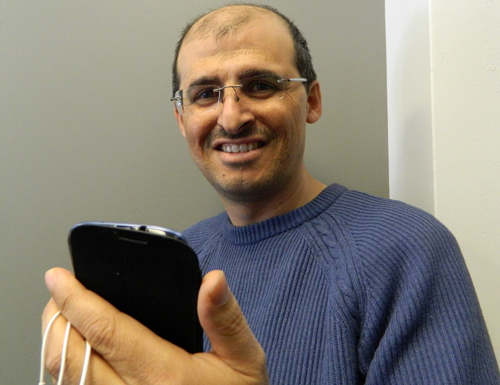
How do you know you have a future engineer among your children? He solves problems.
When Arafat Al-Dweik was a child, his family home in Hebron, Palestine, had two water tanks. The larger one was underground, and pipes led from the main tank to a smaller one on the roof of the house. When the rooftop tank was empty, someone in the family would turn on the pump to refill it with water from the underground tank.
The problem was that if you didn’t turn off the pump at the right time, the water would overflow the tank and soak the roof. “When I was 12, I decided to develop a sensor that would detect the water level and turn the pump off when the rooftop tank was full,” says Al-Dweik, now a professor of engineering at U of G. “I didn’t know a lot about electricity at the time, so I got quite a shock when I touched the wiring, but I was able to make something that worked.”
Al-Dweik was inspired to learn more — if only to avoid more electric shocks — by going to university. He completed his undergraduate studies in Jordan, then attended Cleveland State University in Ohio with a Fulbright Scholarship to complete his master’s and PhD.
After spending two years in the United States designing and implementing wireless communications systems, he moved back to Palestine to teach at the Arab-American University, where he became chair of the Communications Engineering Department. He was then hired by Khalifa University in the United Arab Emirates, followed by Western University in 2011. He joined U of G in August 2013.
His research focuses on high-speed wireless communications. The ability to transmit information quickly facilitates many applications, from medical to security to entertainment. But Al-Dweik’s research looks beyond speed to consider the effects on the environment and health.
“There are lots of indications that too much radiation impacts health,” he says, “and we know that energy consumption affects the environment. My research is looking at new designs for transmitters and receivers that can maintain the quality of the communications while minimizing energy consumption.”
One approach is to develop equipment that can sense the location and level of power needed for each transmission. “They can sense the quality of the channel and adapt,” he explains. “When the source is nearby, they don’t have to transmit at full power, but the user won’t see any difference in quality.” In some systems, energy consumption can be reduced by as much as 80 per cent. Al-Dweik’s work in this area is continuing.
Working with a large group of colleagues, including faculty at Western University and others in the United Kingdom, Finland and the United Arab Emirates, Al-Dweik is moving forward in other research areas, one of which he calls “precision agriculture.” This process involves installing a large number of sensors in farmers’ fields. The sensors measure changing levels of water, fertilizer and other components in the soil and transmit that information to the automated system, which then triggers irrigation or fertilizing equipment to move into action. The information is also sent to a database monitored by farm staff.
“At present, technology is applied to these agricultural issues in Canada by using satellite images and analyzing them to see what’s needed,” says Al-Dweik. “If the soil in a field changes colour, that could indicate that it needs more water, for example, but it’s not easy to rely on those photos.” Many sensors are currently available on the market; the trick is incorporating the technology so they can communicate.
Al-Dweik is working on another project he calls “agile technology.” He recalls driving to Toronto in a recent blizzard. As he crawled along the highway at less than half the speed limit because of poor road conditions and limited visibility, he was passed by another car that was doing about 100 kilometres per hour. That speed was clearly dangerous, but the other driver could have claimed he or she was just following the posted speed limit. Al-Dweik’s solution is to develop technology that would adjust the speed limit depending on road conditions.
“Each car would have a receiver that would tell the driver what the speed limit is in that area and would adjust the speed limit depending on the weather,” he explains. “That adjusted speed would apply regardless of the posted speed limit.” Sensors detecting visibility, temperature and traffic are already in place on Ontario highways, but Al-Dweik’s system would use that information to determine safe speeds. “This not only helps prevent injuries and deaths, but has a huge impact on the environment – one collision can back up cars for hours, wasting fuel and causing pollution,” he says.
With his international team of colleagues – there are nine time zones between Ontario and the Middle East, and the researchers work on Sundays – Al-Dweik says co-ordinating meetings can be challenging. But that hasn’t diminished his passion for research. “This is my passion, what I love to do. I sometimes work 15 hours a day, seven days a week. If you didn’t love it, it would be hell, but I do love it.”
When he’s not at work, he spends time with his family (he has two children) and enjoys playing ping-pong and squash.